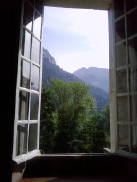Yesterday I gave a talk at a symposium at the 36th annual Cognitive Science Conference. The content of the talk was described this way in our symposium proposal:
Mathematics has been the subject of experimental studies in cognitive science that explore the sensory grounding of number and magnitude. But mathematics also provides conceptual schemes that can manage our comprehension of complex integrated neural activity, like Giulio Tononi’s qualia space. Visual processes, like stereopsis, may be said to be mathematical in character, and the brain is often described as performing computations on sensory data as it constructs the elements of our experience. Mathematician Yehuda Rav has argued that mathematics grows on the scaffolding of cognitive mechanisms that have become genetically fixed with human adaptation. Joselle Kehoe will present a philosophy of mathematics informed by the significance of selected studies in cognitive science and selected moments in the history of mathematics. It will be considered in the light of structural coupling – the embodiment concept of enaction introduced by Varela, Thompson and Rosch.
I had the opportunity to listen to a number of talks and was struck by the extent to which computer modeling governs investigative strategies. These models are designed to mirror neural processing. The models inevitably influence the formulation of new questions, which often provide a refreshing angle on the phenomenon being investigated. But I began to wonder if modeling strategies might not also begin to create conceptual paths from which it may become difficult to exit. It also became increasingly clear to me that modeling of this sort can capture mathematical relationships (like a particular differential equations) in such a way that the formal mathematical description of the relationships could appear to not be necessary. The impulse from some to dismiss the need for formal representations could raise some interesting questions about the nature and the role of these representations. They certainly help identify the paths that connect concepts within mathematics? And these bridges between different branches of mathematics powerfully extend our understanding of both the physical and the conceptual. While many of the things I heard discussed were not designed to talk about what mathematics is, they indirectly addressed exactly that question.
A brief summary of my own talk, with links to supporting content, is this:
A view, held by many in cognitive science, is that an innate sense of magnitude forms a non-symbolic real number system. These are continuous magnitudes that arise from our experience of time, space, motion, etc. This view is supported by the observation that pre-verbal humans and non-verbal animals do perform non-symbolic arithmetic operations on these magnitudes. There are also studies that address how even plants are able to adjust their rate of starch consumption based on the amount of starch they have stored, and the length of time till dawn (when they can begin storing again). Researchers have argued that language, somehow, picked out the discrete integers with which we learn to count (since language itself is a discreet system). The evolution of the real number system in mathematics could then be seen as an investigation of the relationship between number and magnitude. From the Greek separation of quantity (number) and magnitude (the ratios and proportions of continuous quantities like length and time), through the 18th century difficulties with infinitesimals in calculus, and the eventual definitive placement of irrational numbers on the real number line, mathematicians continued to test these relationships and their implications. It is as if this work reflects a struggle to talk about a number system that existed before we were able to talk.
Brain processing itself seems to have a mathematical character – particular neurons in the visual system will only respond to particular orientations (a working abstraction), and optical illusions follow the pattern of statistical judgments (what we see is the most likely interpretation of the retinal image we have). These probabilistic inferences are also used to model learning in a fairly general sense.
Riemann’s 1854 work on the foundations of geometry can be seen as an instance of a mathematician’s point of view being informed by ideas about perception. We know this only because he acknowledged the influence of John Friedrich Herbart in his famous paper on the foundations of geometry. Herbart held the view that space was not the thing that contained the objects around us, but rather a mental image constructed by any number of things seen in relation to each other (including time and color). The combined influence of Gauss and Herbart moved Riemann’s thinking to propose that the concepts of measure and geometry could only have meaning if they began with the most general idea, a manifold, – any collection of elements that were related either discretely or continuously. This work is key to Relativity and points to both set theory and topology.
Mathematics has become increasing significant in the sciences. David Deutsch’s recent work on Constructor theory can be used as an illustration of a mathematics (an algebra in this case) structured to produce, within itself, new statements that cannot be expressed in current physical theories but have new physical theoretical content.
The point of these observations is to suggest that mathematics has played the dual role of characterizing what we see as well as how we see it. If we imagine that an effective body/brain would have a structure that somehow maps with, or couples with its world, then a very interesting question arises – how are we matched? Mathematics may be in the best position to contribute an answer to this question. It may be able to tell us something new about both ourselves, and about how the ‘thoughtful’ is found in nature.
In this way, mathematics is an inquiry like both art and science, looking at our experience and all that we see around us. Perhaps it can be used to refresh our view of both.


Recent Comments